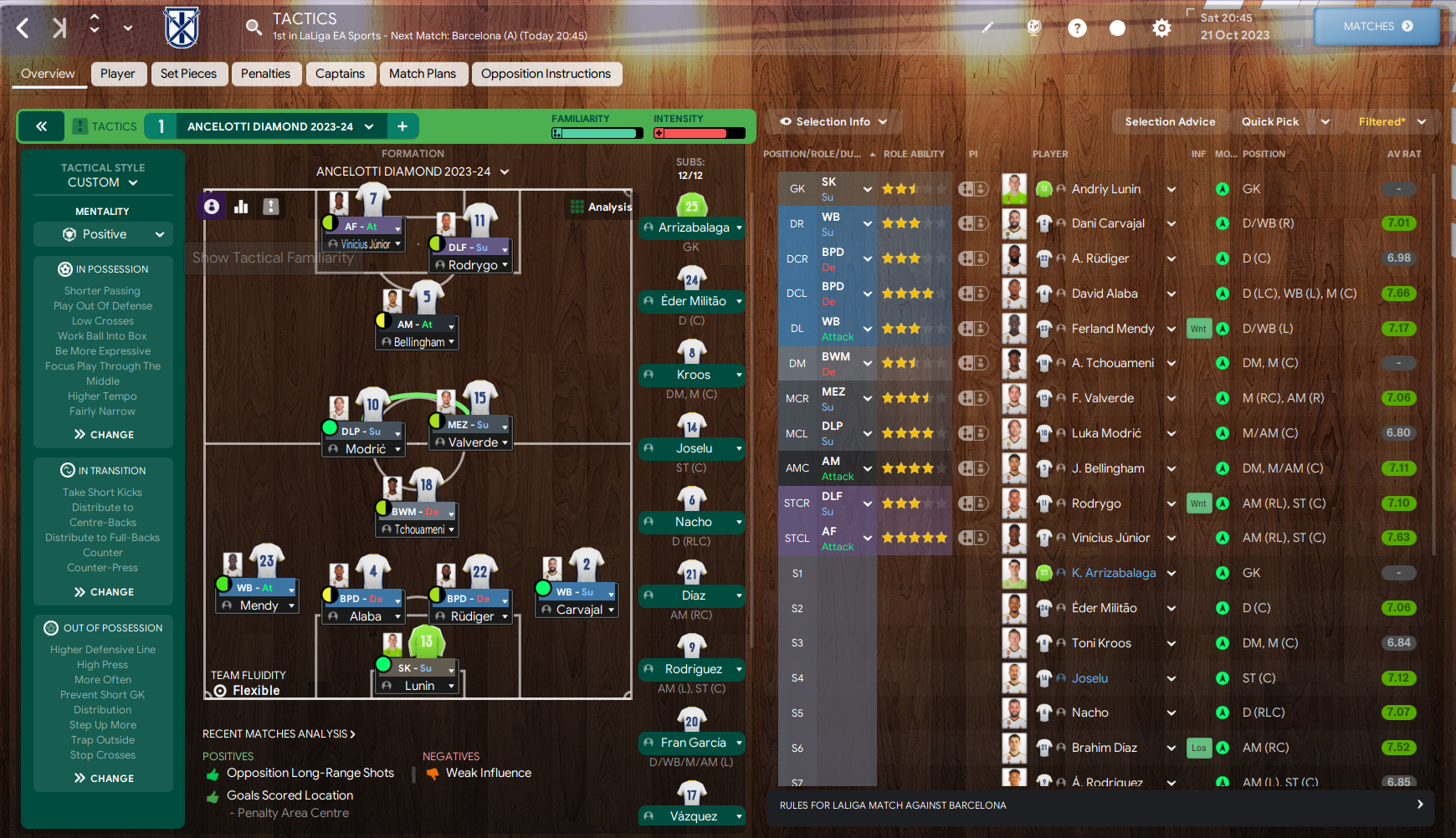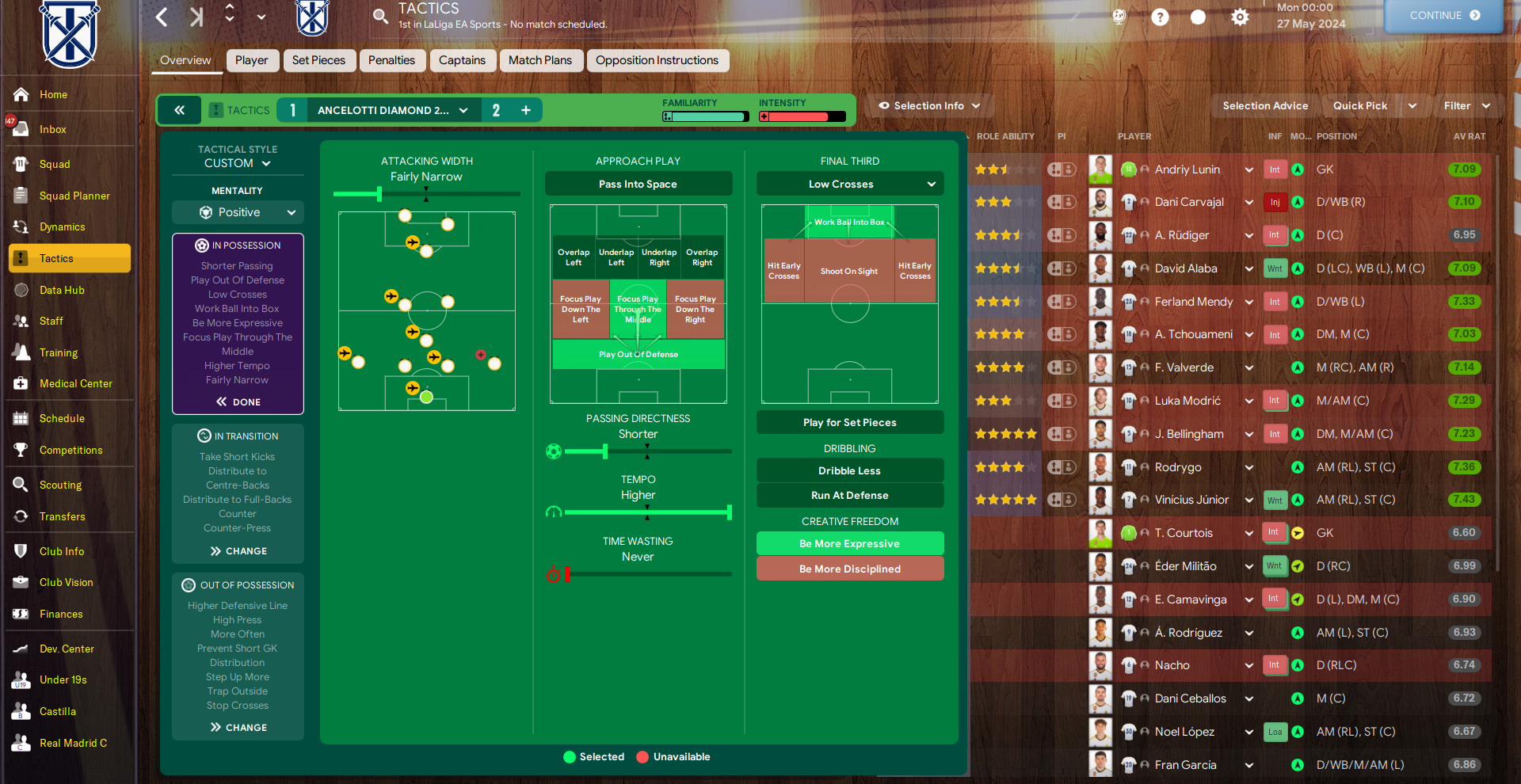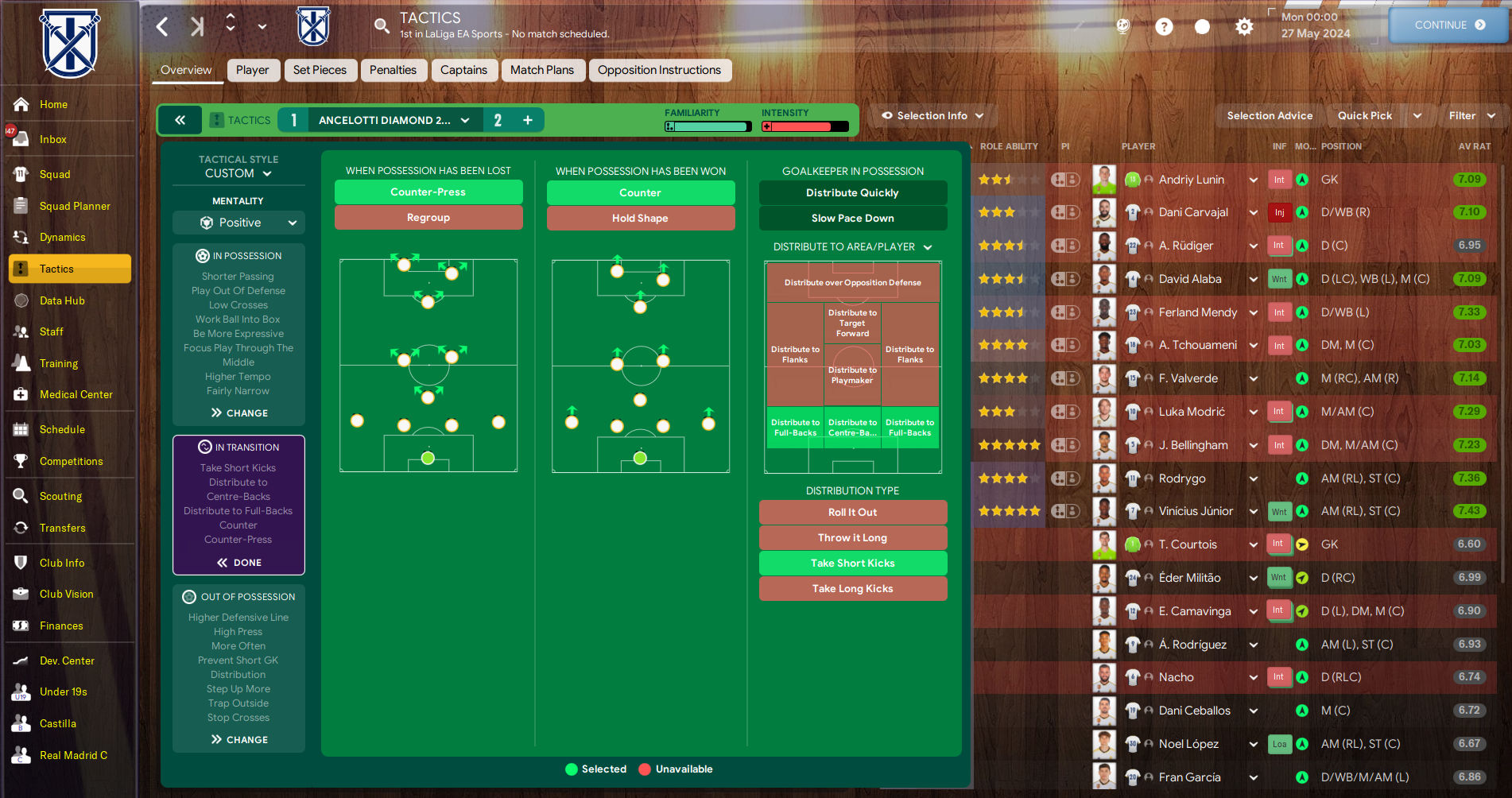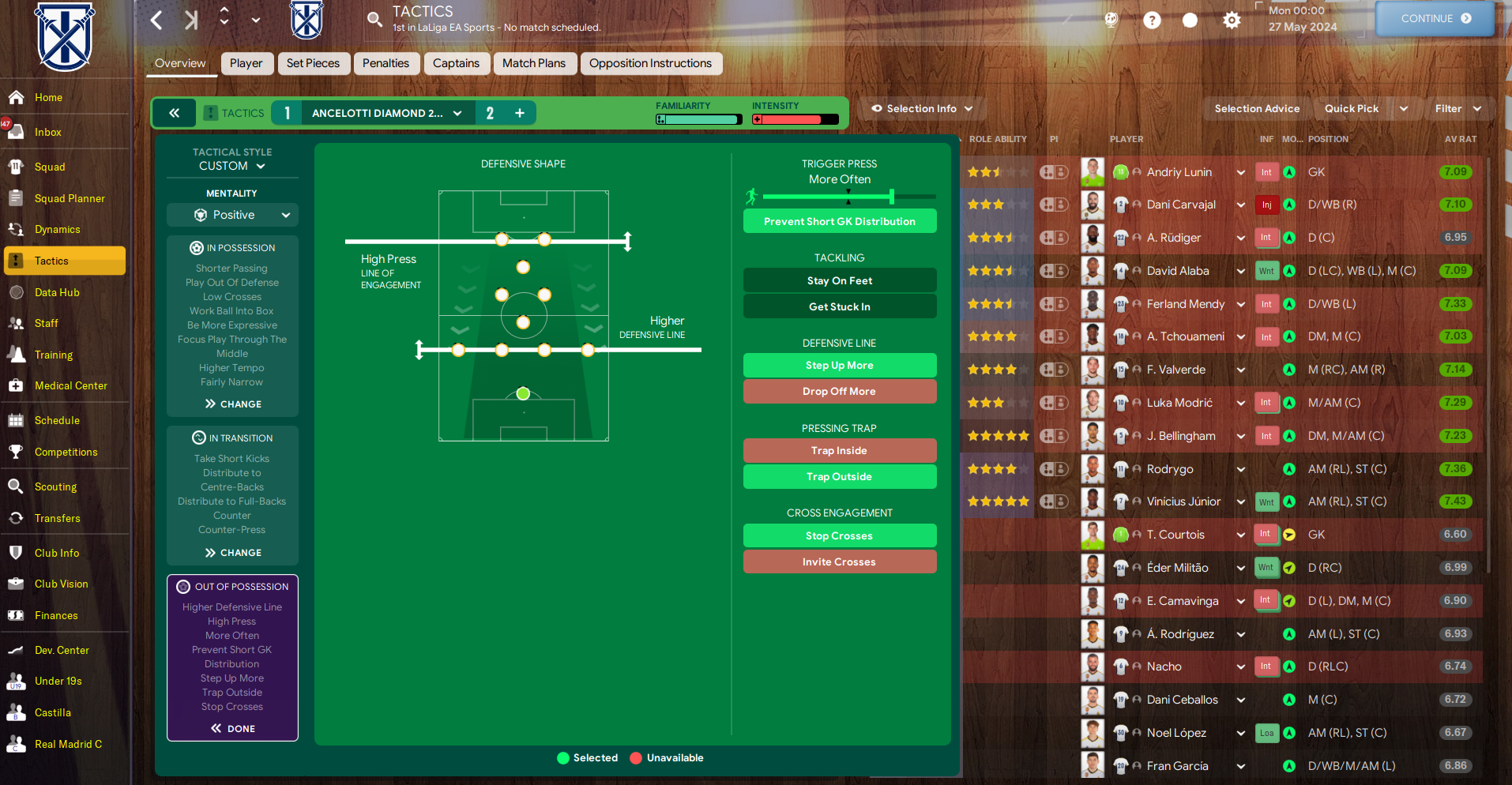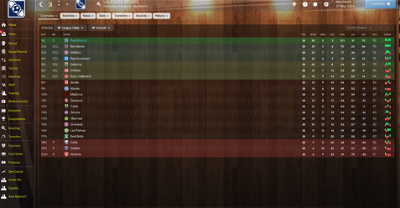| Tester | Team | ME | Win % | PPG | AGF | AGA | GD | PL | W | D | L | |
|---|---|---|---|---|---|---|---|---|---|---|---|---|
| Deleted User #1866315 |
 Real Madrid
Real Madrid
|
24.2.1 | 79% | 2.5 | 2.7 | 0.8 | 1.84 | 38 | 30 | 5 | 3 |
Unveiling Ancelotti's Midfield Maestro: Orchestrating Real Madrid's Success
Despite losing key attacking talent, Real Madrid entered the season facing skepticism. The absence of Karim Benzema and missed transfer targets like Kylian Mbappé fueled doubts about their potential. However, Carlo Ancelotti's astute midfield management has emerged as a pivotal factor in their ongoing success.
While Jude Bellingham's arrival from Borussia Dortmund bolstered their midfield options, Ancelotti already possessed a formidable array of talent: Toni Kroos, Luka Modrić, Eduardo Camavinga, Aurélien Tchouaméni, and Federico Valverde. With only eleven players taking the field, achieving the optimal midfield balance became crucial for Ancelotti's Champions League aspirations. This analysis delves into these players' strengths and explores Ancelotti's tactical strategies deployed so far.
The season's early stages saw Ancelotti take a bold approach, leaving out both Modrić and Kroos for a diamond midfield formation. Tchouaméni anchored the base, flanked by Camavinga and Valverde as box-to-box midfielders, with Bellingham playing in the hole behind the strikers. However, sluggish performances against Celta Vigo and Athletic Bilbao raised concerns. Real Madrid lacked control and organization in possession until Modrić or Kroos entered the fray. Since then, Ancelotti has consistently included at least one of these veterans, opting for a more experienced presence, except for the Madrid derby loss where both started.
Understanding the Real Madrid Context:
Before delving into individual player comparisons, it's crucial to consider Real Madrid's unique club culture. Unlike their possession-focused rivals Barcelona, Real Madrid doesn't adhere to a rigid playing style. Coaches with overly methodical approaches (like Rafa Benítez and Julen Lopetegui) often struggle to adapt. While not completely unrestrained, the players at Real Madrid value a degree of freedom and prefer to express themselves on the pitch. However, achieving harmony within this framework remains paramount.
Real Madrid's Dynamic Offensive Approach: Freedom Over Structure
Real Madrid isn't a team defined by rigid positional play. Instead, Ancelotti empowers his players with freedom, trusting their individual quality and decision-making on the pitch. This is evident in their attacking approach, which transcends predefined structures like 3-2-2-3 or 4-3-3. Even formations like the "4-D-2" on paper don't fully capture their dynamic movement.
For example, against Napoli in the Champions League, we see eight Real Madrid players clustered on the left flank. While this might appear unbalanced from a positional perspective, lacking width to stretch the opponent's defense, Ancelotti allows this flexibility. This approach created a temporary numerical advantage (8v5) around the ball, exploiting Napoli's defensive positioning.
The core of this "relational attack" lies in the experience and self-organizing ability of Modrić and Kroos. During build-up, Kroos drops deep on the left, positioning himself outside the opposition's shape to receive the ball freely and initiate attacks. This is evident in his high volume of progressive passes from that flank.
Modrić, on the other hand, prefers the right side but enjoys the freedom to roam across the pitch. His influence shines in the final third, particularly facilitating entry into the penalty box on the right. However, both players have limitations defensively, prompting Ancelotti's reluctance to start them together frequently.
Kroos' lack of defensive intensity on the left flank would burden attackers like Vinícius Jr. or Fran García. Ancelotti prioritizes midfielders with the mobility and stamina to cover that area. While Modrić remains fit, his playing style doesn't perfectly fit the box-to-box role, making Camavinga or Valverde more suitable choices in certain situations.
The answer to why Ancelotti doesn't simply replace the veterans with young talent lies in Kroos' irreplaceable role. Despite Tchouaméni's forward passing ability, Camavinga offers different strengths, with his passing not being his defining characteristic. He brings other valuable qualities to the team.
Real Madrid's Midfield Dynamics: Balancing Attack and Defense
Attacking Freedom:
While not strictly adhering to positional play, Real Madrid empowers its midfielders with freedom, trusting their individual qualities and decision-making. This dynamic approach transcends predefined formations, evident in situations like the clustered players on the left flank against Napoli. This flexibility creates temporary numerical advantages, exploiting opposition weaknesses.
The core of this "relational attack" lies in the experienced duo of Modrić and Kroos. During build-up, Kroos drops deep on the left, receiving the ball freely and initiating attacks with progressive passes. Modrić, preferring the right side, enjoys roaming across the pitch, influencing final-third play, particularly facilitating entry into the penalty box.
However, their limitations in high-intensity defensive work prompt Ancelotti's cautious approach to starting them together frequently. Kroos' lack of defensive presence burdens attackers on the left, while Modrić's playing style doesn't perfectly fit the box-to-box role. This opens doors for Camavinga and Valverde to excel in certain situations.
Distinct Roles:
Bellingham and Valverde primarily impact the game closer to the penalty box. While Camavinga possesses forward-carrying abilities, Valverde offers more crosses and overlaps on the right, contrasting Camavinga's focus on carrying the ball forward. Notably, Valverde possesses a powerful shooting range, evident in his numerous shots from outside the box.
Bellingham, on the other hand, thrives as a "fox in the box," utilizing his late runs and intelligent positioning to finish chances. His presence has proven crucial in tight games, exemplified by his goal against Union Berlin. Additionally, his ability to sense weak channels complements Real Madrid's skilled passers, as seen in the goal against Almería.
Following Karim Benzema's departure, Bellingham's penalty-box involvement becomes even more essential. While Joselu might not replicate Benzema's scoring prowess, Bellingham's contributions in this area remain vital. However, his potential extends beyond penalty-box presence, suggesting a more all-rounded development in the future.
Defensive Concerns:
Despite their dynamic attack and conceding few goals initially, Real Madrid has struggled to find the right defensive balance in their penalty box since Casemiro's departure. They consistently concede similar chances, particularly from crosses targeting the space between the six-yard box and the penalty spot.
While their ability to defend outside the box and block long shots remains commendable, this specific area remains a significant concern. Casemiro's defensive awareness and ability to cover teammates and gaps in the penalty box allowed other midfielders to press higher without worrying about the space behind them.
Currently, no player in the squad replicates Casemiro's defensive output in the penalty box. This vulnerability was evident in the Madrid derby, where Atlético Madrid repeatedly exploited this weakness. Similar situations occurred in away matches against Girona and Sociedad, highlighting the need for addressing this defensive vulnerability.
Conclusion:
Real Madrid's success has often transcended individual limitations. However, addressing their current defensive concerns in the penalty box remains crucial for continued success. Analyzing past strategies with Casemiro and exploring potential solutions within the current squad will be vital in achieving this balance.
HOW TO EMULATE THIS TACTIC IN FOOTBALL MANAGER 2024
To emulate Ancelotti’s Real Madrid, I created two different tactics, a 4-1-2-1-2 with a narrow-diamond midfielder and a 4-3-1-2 with a central midfielder’s trio.
Team instructions are the same for both tactics, only players roles and personal instructions may slightly variate. In this analysis I will focus only on the first tactic.
1) Ancelotti’s Diamond Narrow
Mentality: positive
In possession instructions
Attacking width: fairly narrow to be more compact
Passing: shorter (that matches with the fairly narrow width)
Tempo: higher
Play out of defense
Focus play through the middle to overload the central area
Low crosses: we don’t have tall strikers in our Real Madrid squad, but very fast strikers like Vinicius Jr. and Rodrigo
Work the ball into the box
Be more expressive: this gives more freedom to our players, that’s what Ancelotti exactly wants, as I said in the analysis.
In transition
Counter-press: to instruct our players to win the ball as soon as possible applying pressing
Counter: launch fast counter-attacks after winning the ball
Distribute ball to center-backs and full-backs: this to help build the play from the back
Take short kicks: instruction that matches with the ball distribution
Out of possession
High pressing line and higher defensive line: to maintain our team compact
Pressing: more often
Step up more: apply off-side trap
Trap outside: force our opponents to play hugging the touchline
Stop crosses: this is how I tried to solve Real Madrid’s problem that I mentioned in the analysis above.
Player roles and instructions
Defense:
Lunin (Courtouis) : sweeper-keeper in support, no instructions
Dani Carvajal: wing-back in support, no instructions
Antonio Rudiger: ball-playing defender in defense: dribble more, to instruct him to carry the ball forward and help the build-up
David Alaba: ball-playing defender in defense: stay wider: to cover Mendy when he pushes forward
Ferland Mendy: wing-back in attack, no instructions
Midfield:
Aurelien Tchouameni: ball-winning midfielder (deep position) in defense: no instructions,
Federico Valverde: mezzala in support: mark tighter, shoot more often: as said in the analysis, Valverde has a great shoot ability and often tries long range shots that hit the target
Luka Modric (Toni Kroos): deep-lying playmaker in support: no instructions. Here, one could say that, since both Kroos and Modric try to drop down left to find spaces without being pressed by the opponent, a carrilero role could be better, because this role has “stay wider” as preset player instruction. But I believe Modric and Kroos role is more that of a playmaker who builds up the play rather than a carrilero. I did not instruct him to stay wider in either of my two tactics because I want him to focus only on passing the ball, he will decide where to go according to the situation. Sometimes it’s better not to give too many personal instructions to our players because good players like Modric already know what to do.
Jude Bellingham: in both tactics, his role is an attacking midfielder in attack: roaming from position, because I want him to find spaces where he can create chances in and outside the box, move into channels because I want him to go inside the box and tackle harder because I want him to press the opponents and win the ball back.
Vinicius Jr: advanced forward-attack: stay wider because he often runs to the left side and plays from an inside forward position, roam from position to give him freedom to find spaces and tackle harder to instruct him to press and win the ball.
Same instructions for Rodrygo but he is a deep-lying forward in support, I want him to link the play more and drop down, so I instructed him to shoot less often and prefer passing.
In this tactic I used two forwards with different roles, one more attacking (Vinicius Jr.) and the other more focused to link the play. In the second tactic, the 4-3-1-2 I used both Vinicius Jr. and Rodrygo as advanced forwards in attack with the same personal instructions or Rodrygo as a complete forward. I don’t like to use double roles especially the two advanced forwards combination because in past editions of Football Manager it “broke” the game and in Football Manager 2024 sometimes it does so. But, if we want to stick to reality and faithfully emulate Ancelotti’s tactic, we can use the two advanced forwards.
Results
I used the first tactic in this season and I won the Spanish Liga with 95 points (30 won, 5 draw, 3 lost) and the best attack (101 goals) and playing beautiful football, dominating XG and possession.
That’s all for this tactic. I hope it works for you too.
If you like my tactics please like the video on youtube and subscribe to my channel
Thank you very much
Test Results
 Real Madrid
Real Madrid
You'll need to Login to comment
